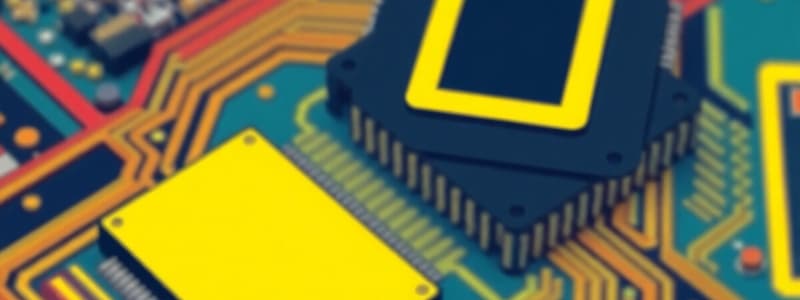Podcast
Questions and Answers
Which of the following is NOT a core component of a computer's hardware?
Which of the following is NOT a core component of a computer's hardware?
- Operating system (correct)
- Central Processing Unit (CPU)
- Random Access Memory (RAM)
- Storage Device
What is the primary function of the Central Processing Unit (CPU)?
What is the primary function of the Central Processing Unit (CPU)?
- Storing data and instructions permanently
- Fetching, decoding, and executing instructions from programs (correct)
- Displaying visual information
- Converting AC power to DC power
Which of the following would NOT be considered an input device?
Which of the following would NOT be considered an input device?
- Microphone
- Keyboard
- Monitor (correct)
- Touchscreen
What is the main advantage of using a Solid State Drive (SSD) over a Hard Disk Drive (HDD)?
What is the main advantage of using a Solid State Drive (SSD) over a Hard Disk Drive (HDD)?
What does the term 'volatile' mean in the context of computer memory (RAM)?
What does the term 'volatile' mean in the context of computer memory (RAM)?
What is the purpose of the motherboard in a computer system?
What is the purpose of the motherboard in a computer system?
Which of the following is NOT typically a function of an expansion card?
Which of the following is NOT typically a function of an expansion card?
What is the primary role of the Power Supply Unit (PSU) in a computer system?
What is the primary role of the Power Supply Unit (PSU) in a computer system?
Flashcards
Computer Hardware
Computer Hardware
Physical components of a computer system that work together.
Central Processing Unit (CPU)
Central Processing Unit (CPU)
The brain of the computer that executes instructions.
Random Access Memory (RAM)
Random Access Memory (RAM)
Volatile memory used for storing data temporarily.
Hard Disk Drive (HDD)
Hard Disk Drive (HDD)
Signup and view all the flashcards
Solid State Drive (SSD)
Solid State Drive (SSD)
Signup and view all the flashcards
Motherboard
Motherboard
Signup and view all the flashcards
Graphics Processing Unit (GPU)
Graphics Processing Unit (GPU)
Signup and view all the flashcards
Power Supply Unit (PSU)
Power Supply Unit (PSU)
Signup and view all the flashcards
Study Notes
Introduction to Computer Hardware
- Computer hardware refers to the physical components of a computer system.
- These components work together to execute instructions and perform tasks.
- Key components include the central processing unit (CPU), memory (RAM), storage devices (HDD, SSD), input/output devices (keyboard, mouse, monitor), and motherboard.
Central Processing Unit (CPU)
- The CPU is the "brain" of the computer.
- It fetches, decodes, and executes instructions from programs.
- CPUs have multiple cores for parallel processing, increasing speed.
- Clock speed, measured in gigahertz (GHz), dictates the processing rate.
- CPU performance is crucial for overall system speed.
Memory (RAM)
- Random Access Memory (RAM) is essential for storing data and instructions.
- RAM is volatile, meaning data is lost when the computer is off.
- RAM speed and capacity directly impact system performance.
- More RAM allows for running multiple programs simultaneously.
Storage Devices
- Storage devices store data permanently.
- Hard Disk Drives (HDDs) use magnetic platters for storage.
- Solid State Drives (SSDs) use flash memory chips, faster and more resilient.
- Storage capacity is measured in gigabytes (GB) or terabytes (TB).
Input/Output Devices
- Input devices allow users to interact with the computer.
- Examples include keyboards, mice, scanners, microphones, and touchscreens.
- Output devices display or transmit the results of computer processing.
- Examples include monitors, printers, speakers, and projectors.
Motherboard
- The motherboard is the main circuit board.
- It connects and controls all other hardware components.
- It houses the CPU, RAM, and expansion slots for additional devices.
- Crucial for enabling communication between computer parts.
Graphics Processing Unit (GPU)
- GPUs are specialized processors for handling graphics and visual tasks.
- Particularly important for gaming, video editing, and graphic design.
- Modern GPUs often include dedicated memory to further enhance performance.
Expansion Cards
- Expansion cards are add-on circuits that add functionality to a computer.
- Examples include sound cards, video cards, network cards, and TV tuner cards.
- They often plug into slots on the motherboard.
Power Supply Unit (PSU)
- The PSU converts AC power to DC power to run computer components.
- Different PSU models cater to various needs and power consumption rates.
- Proper wattage is essential to accommodate all components and prevent damage.
Cooling Systems
- Cooling systems are vital for preventing computer overheating during operation.
- Fans, heatsinks, and liquid cooling systems are widely used to manage temperatures.
- Overheating can severely damage the hardware and affect its performance.
Studying That Suits You
Use AI to generate personalized quizzes and flashcards to suit your learning preferences.




